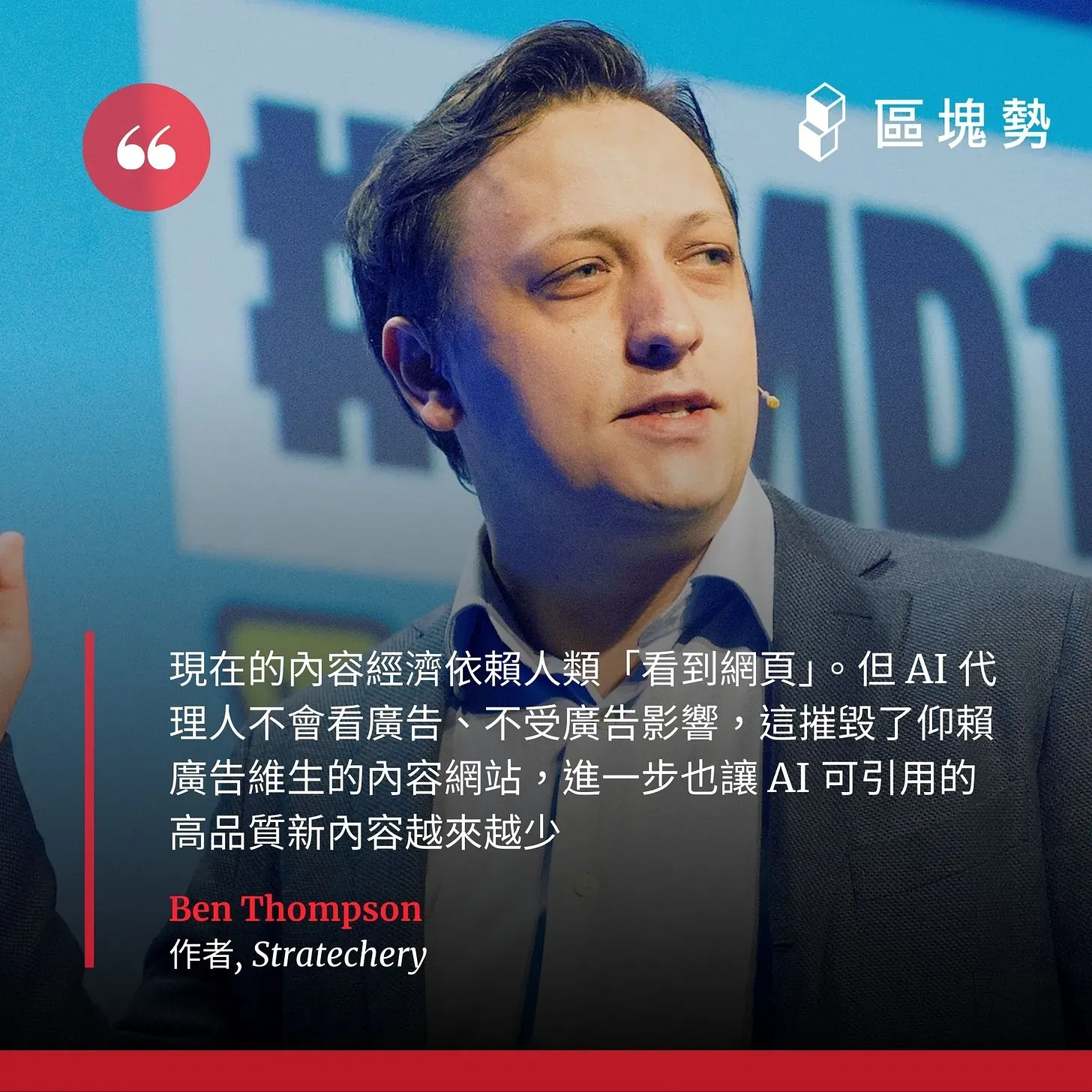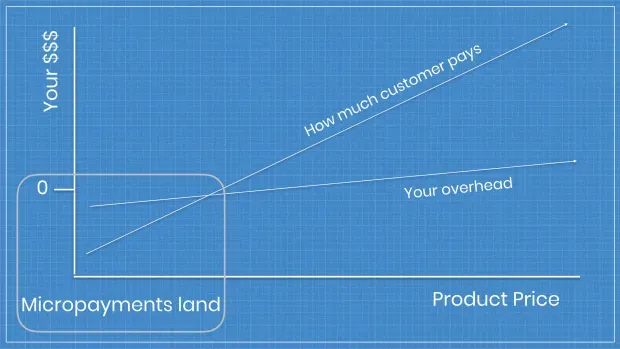Who Will Pay for Online Content When AI Doesn’t Look at Ads?
GM,
This is Blocktrend’s 693rd article. Here’s a little heads-up: Blocktrend plans to launch a lifetime membership subscription with the 700th article, and will also adjust the subscription rate to $10 per month or $100 per year. The new pricing will only apply to new subscribers or members who cancel and later resubscribe — the pricing for existing subscribers will remain unchanged.
Now, onto the main topic. Last week, well-known tech analyst Ben Thompson published a public essay titled The Agentic Web and Original Sin, pointing out that the long-standing business model supporting online content — advertising — has reached its limit. The reason? Ads are designed for humans, but AI doesn’t look at ads.

This perspective echoes an earlier Blocktrend article titled The Forgotten 402: How It Could Become the Most Important Payment Gateway in the AI Era. The reason the x402 payment protocol matters isn’t because people will suddenly switch to using cryptocurrency — it’s because AI doesn’t follow human habits. But if ads disappear, then who’s going to pay for online content?
AI’s Attention Is Not Scarce
Advertising has been the most important business model on the internet. Open up Spotify, YouTube, or any social media platform, and as long as users don’t pay, they’ll have to watch ads. I’ve previously said that the reason the internet evolved toward an ad-based model comes down to technical limitations back then:
The reason we rarely see “402: Payment Required” is because everyone found workarounds long ago… Although narrowband networks were connected, payment mechanisms didn’t keep pace… Most online content required payment… but because payments had to be tied to an account, the lack of native internet payments led to all sorts of detour solutions.
In his latest essay, Ben Thompson points out an even deeper reason: the internet has always been human-centered. All current online business models were designed for people. Human attention is a scarce resource, and advertising has been the best way to monetize it. He argues that advertising isn’t some technical compromise; it’s actually a win-win-win strategy for everyone involved:
- Users get free access to content and services
- Content creators reach the widest possible audience
- Advertisers effectively target potential customers
This system has sustained the internet ecosystem for the past two decades — until a new disruptor emerged: AI.
Just last week, I asked about 50 participants at an event: “If you want to look up the history of Bitcoin Pizza Day, would you ‘ask AI’ or ‘search Google’?” About two-thirds of the audience chose to ask AI. This shows that in the future, an increasing portion of website visitors won’t be human — they’ll be AI. But the current internet business model isn’t prepared for AI at all.
AI has infinite energy: it can read in seconds what would take a human an entire year, and yet along the way, it never clicks on banner ads nor forms brand impressions. When websites can no longer capture human attention, how much longer can an advertising model — designed purely for people — survive?
No One Watching the Ads
Ben Thompson predicts that in the AI era, text-based websites will be the first to feel the impact:
Websites supported by advertising — especially those centered on text — will be in the worst position. Most ad-supported content is already of poor quality, thanks to bad economic incentives and the unsustainable model of near-zero marginal production and consumption costs.
While the advertising model creates a “win-win-win,” it has come at the cost of content quality.
We’ve been able to access internet content for free because ads foot the bill. That three-way win has worked up to now. But with the rise of AI, the cycle is breaking. AI agents don’t click ads or take out subscriptions. They consume content — but they don’t pay (by watching ads). As a result, web traffic collapses, content creators lose funding to produce, and ultimately, even AI will struggle to find quality sources worth citing.
Who Gets Wiped Out?
For most content websites, the business strategy has been mass production, search ranking optimization, and click attraction. Since the advent of generative AI, the “content farm” competition has only become more cutthroat — everyone’s trying to squeeze more ad revenue out of fewer resources.
Many news websites today rely heavily on AI to write news briefs, simply rewording reports from other media to quickly pump out their own articles. In the short term, these sites can still depend on Google Search for traffic and convert that into ad revenue — but only as long as users are still “searching” and “clicking.”
As more people turn to AI for summaries and recommendations, bypassing the websites themselves, advertisers will notice diminishing returns on their ad spending, because the human readers are gone — replaced by AIs that don’t “understand” ads. Once the win-win-win cycle breaks, traffic-dependent websites won’t survive. Yet, this is an arms race no one can avoid.
People often say that in today’s world, those who know how to use AI will replace those who don’t. If you don’t use AI to rapidly generate content, someone else will grab the traffic first. But this is also a form of drinking poison to quench thirst: the more AI is used, the less originality there is. To AI, duplicated content is worthless. In the past, advertisers paid for clicks and attention, but now, what AI wants to buy is the content itself.
Who Will Win?
AI wants content that is well-structured, offers clear perspectives, and provides reliable, citable data. It won’t be drawn in by clickbait headlines, and it can instantly detect if a “10,000-word long read” is just filled with fluff. In other words, consistently high-quality, original content will become AI’s top-choice database. As long as the AI deems, “This is worth reading,” it will pay directly. The creators producing content that AI is willing to pay for will become the new winners.

This is similar to today’s paid subscriptions or crowdfunding models, where it’s the readers who pay directly for content — rather than paying with their attention. But now there’s a new paying customer in the mix: AI. So the big question for websites is, how should they respond?
Micropayments Are Becoming Feasible
Not long ago, micropayments on the web were still seen as an unworkable option. Recently, I came across a 2020 article titled 402 Payment Required: Why Micropayments Are Doomed to Fail by Artur Piszek, who analyzed the structural economic reasons why micropayments were destined to flop. My favorite illustration in that article compares it to buying popsicles: no one would pay $150 in shipping just to buy a $15 popsicle.

The chart’s horizontal axis shows the price of the product, and the vertical axis shows the total payment cost. The key takeaway is the boxed area in the bottom-left corner — the “micropayment zone.” When the product price is too low, the logistics or transaction costs exceed the value of the product. If the shipping (or transaction) costs are passed on to the consumer, people would rather not buy; if the seller absorbs the cost, they usually impose a minimum purchase quantity.
Artur Piszek argued that the cost of online payments lies precisely here, making micropayments doomed to fail. But what he didn’t anticipate was that technological upgrades have already dramatically reduced online payment costs.
In the eyes of Stripe CEO Patrick Collison, stablecoins have become the financial world’s “room-temperature superconductor,” capable of moving money across vast distances with minimal friction.

Superconductors are known for their extremely high conductivity. If we could install solar panels in the desert and transmit that electricity across thousands of miles with zero loss, it would fundamentally change how we build power grids. The catch, of course, is that superconductors usually only exist under high pressure and at extremely low temperatures, making them hard to apply outside the lab. The great promise of a room-temperature superconductor is that it can be used widely in everyday life.
Patrick describes stablecoins as the room-temperature superconductor of financial services because they dramatically lower the cost of online payments, finally making micropayments on the internet feasible. For the past two decades, content creators trying to make money have had to appeal to human audiences — chasing clicks, jumping on trends, grabbing attention. But the future looks different. To appeal to AI, the key might be producing original, high-quality content worth paying for.
Back to the headline: Without advertising, who will pay for online content? In my ideal scenario, half the subscribers would be AI, and half would be humans. If only AI is willing to subscribe, it means the content is substantial but perhaps boring to people. If only humans subscribe, it suggests the content is entertaining but lacks depth.
The best situation is this: AI decides that Blocktrend is worth paying for, and humans are also willing to spend time reading it — not just because it’s substantial, but because it’s engaging too.
p.s. Blocktrend moved to Substack five years ago, and many readers have been supporting it continuously with their credit cards since then. Since most credit cards have a five-year validity period, we’re now reaching a peak period of card renewals. To the friends who choose to unsubscribe, I sincerely thank you for your past support. And to those willing to update their payment details and join me for the next five years, I will cherish your support even more. Click here to check your current subscription status.





